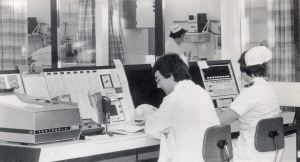Other Achievements

Dr Emslie-Smith's programme for a Cardiac Symposium in Dundee in 1963 (private collection)
Professor Hill's team spent much of their time teaching. Regular Easter postgraduate cardiology courses proved very popular, attracting many delegates from overseas. A number of symposia with cardiology topics were also arranged, which attracted distinguished national and international figures. Dundee Medical School's reputation as a cardiac centre of distinction was growing, and in 1963 Professor Hill was able for the first time to attract to Tayside the elite Association of Physicians of Great Britain and Ireland and the British Cardiac Society (now much enlarged and renamed the British Cardiovascular Society).
In 1955, Emslie-Smith spent a year in Melbourne where he studied the ECG in experimental hypothermia. He elucidated the whole electrocardiographic syndrome of hypothermia in animals and man, and gave the name 'J wave' to the conspicuous extra deflection. When routinely reporting ECGs at Maryfield Hospital on his return to Dundee, he recognised cases with characteristic ECG patterns of hypothermia. By recording rectal temperatures with a long laboratory thermometer in acute admissions, he was able to clarify the clinical picture of accidental hypothermia and emphasise its importance in the community. He was the first to show that elderly people in the UK could become dangerously hypothermic in their own homes.
Spatial vectorcardiography was a big interest from 1966-75 after Emslie-Smith had acquired the technique in Melbourne. Studies on myocardial infarction, arrhythmias and posture led to several publications, two PhD theses and a number of lecture invitations. Emslie-Smith and Lowe also presented this topic in Sir John McMichael's 1968 festschrift.
50 years ago, patients with acute myocardial infarction fortunate enough to reach hospital were treated largely with benign neglect, sedated and put in a bed in a quiet part of the ward.
However, in 1961 Dr Desmond Julian articulated the concept of the coronary care unit. Mortality immediately fell by half and these units subsequently spread like wildfire.

Chief technician John Gallagher operating a Lown cardioverter at DRI in the 1960s. Awarded to Emslie-Smith by the British Heart Foundation for research, this was soon, and often, used in the routine treatment of atrial fibrillation. (image from ERHB magazine)

Coronary Care Unit at Ninewells, 1977 (courtesy of NHS Tayside)
In 1962, Mr John S Stewart and Dr Bill Stewart reported on the heroic resuscitation of a young man from cardiac arrest complicating hyperkalaemia, where the surgeon performed open cardiac massage for two and a half hours.
The important learning point was that it was not until the patient's acidosis was corrected by intravenous sodium bicarbonate that satisfactory cardiac action was secured, and subsequent publications emphasised the importance of correcting acidosis during cardiac arrest.
Ninewells was planned before coronary care units were envisaged, and so the units established at Maryfield Hospital and Dundee Royal Infirmary transferred to temporary quarters in Ward 14 until the new unit at Ward 21 opened in 1977.
The computerised ECG monitoring system devised by Hewlett Packard was the first of its kind to be installed in the UK.
A mobile coronary care unit with fully equipped van and standby vehicle was introduced at the same time as the main hospital unit at Ninewells opened. By 1983, the van had been called out 3,500 times, taking on average 13.5 minutes to reach the patient. Resuscitation was attempted an average 32 times per year with a success rate approaching 40%. The service unfortunately ceased after one too many (van) crashes.
Back to exhibition homepage